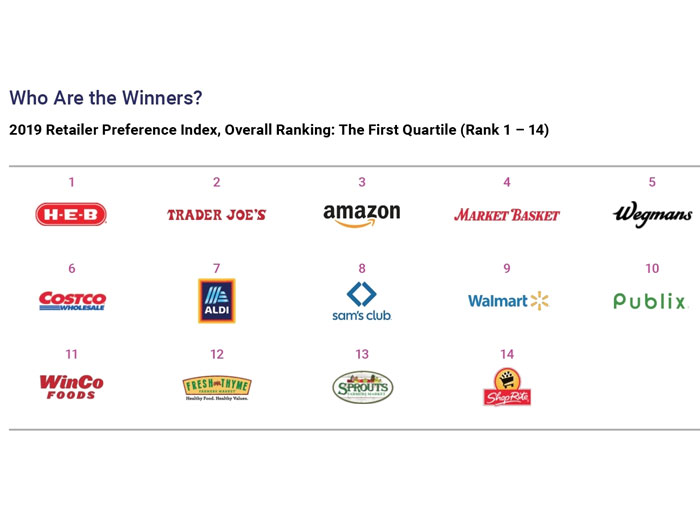H-E-B Dethrones Trader Joe’s as Top U.S. Grocery Retailer in the 2020 dunnhumby Retailer Preference Index
January 8, 2020 | 5 min to read

CHICAGO—dunnhumby, the global leader in customer data science, today released the third annual dunnhumby Retailer Preference Index (RPI), a comprehensive, nationwide study that examines the $700 billion U.S. Grocery market. For the first time, H-E-B was rated the top U.S. grocery retailer bumping Trader Joe’s from the top spot which the discounter has held the last two years. The regional grocery retailer from Texas also jumped ahead of Amazon and Costco.
The other grocery retailers with the highest overall customer preference index scores are: 2) Trader Joe’s, 3) Amazon, 4) Market Basket, 5) Wegmans Food Markets, 6) Costco, 7) Aldi, 8) Sam’s Club, 9) Walmart, 10) Publix, 11) WinCo Foods, 12) Fresh Thyme, 13) Sprouts Farmers Markets, 14) ShopRite. The RPI study surveyed 7,000 U.S. households to determine which of the top 60 largest grocery retailers have the strongest combination of financial performance and consumer emotional sentiment.
“One of the most important findings is that leading traditional regional grocers are experiencing a resurgence in customer preference, by winning with relevance and convenience,” said Jose Gomes, President of North America for dunnhumby. “If they can compete on price and quality — the value core for grocers — they are especially well-positioned to fend off the growing threat of non-traditional players. This also leaves them better insulated against an economic downturn. In the end, there is no ‘one size fits all’ approach to winning in this market, and retailers with Customer First strategies are most likely to fare best.”
The overall RPI ranking evaluates retailer performance on seven pillars: price, quality, digital, operations, convenience, discounts/rewards and speed. The retailers who focus their business on superior value perception – defined by the strongest combination of price and quality – tend to have the most financial success and the strongest emotional bond with customers.
Key findings from the study:
- Leading traditional, regional grocers are winning with relevance and convenience. Regional powerhouseH-E-B’s move into first place — due to sustained focus and excellence on assortment relevance and private brand — is consistent with dunnhumby’s findings that some regional grocers are getting stronger and are now going toe-to-toe with leading non-traditional retailers. By focusing on relevance, particularly assortment relevance, leading traditional grocers are leveraging their location advantages and making convenience a bigger part of determining which retailers are winning and losing.
- H-E-B, Fry’s, Smith’s and Kroger, all leading regional grocers, standout as being just as prepared for the next economic downturn as industry superstar Costco, due to having excellent private brands, highly relevant promotions, better existing price perception, and lower cross-shopping by their customers with Walmart, Aldi and Dollar General.
- Convenience has grown more in importance than any other customer need, due to the efforts of traditional grocers. While still not as important as price or quality, its impact on emotional bond and financial performance has doubled the past three years. Assortment relevance is also becoming a more powerful lever for driving convenience.
- For the third year in a row, price and quality remain the two most important customer needs that retailers must meet. Together, these form the core of value perception. They have the largest impact on retailer financial performance and customers’ emotional bond with retailers.
- Price is the more important half of the value core for shoppers of almost all incomes. The top five grocery stores for price are 1) Aldi, 2) Market Basket, 3) WinCo, 4) Lidl, and 5) Trader Joe’s. It isn’t until annual household incomes reach $200k that customers will generally favor quality in the value core. Also, price-first retailers have grown twice as fast as quality-first retailers over the past five years, with Aldi and the big dollar chains growing faster than almost any retailer measured.
- Amazon Go shows that Amazon has strong brick-and-mortar grocery chops. When Amazon opens their branded chain of brick-and-mortar grocery stores, retailers can expect Amazon to offer a strong value core, supported by an excellent private brand, high quality ready-to-eat, decent perishables, great price perception and speed of shopping.
- Not all discounters are faring well. Lidl is living in the space between hard discounter and the typical traditional grocery store and failing to excite customers. Despite having excellent price perception, Lidl’s price perception isn’t as strong as Aldi’s, and they have operational and assortment relevance issues that Aldi doesn’t. They don’t focus clearly on a few categories like Aldi does, and they have jumped more into promotions and rewards than Aldi.
The latest dunnhumby RPI is available for download today at: http://bit.ly/35r4eXi. Retailers included in the RPI that are interested in receiving their individual banner profiles can visit dunnhumby’s booth #4673 at NRF 2020, speak with their dunnhumby account executive, or contact dunnhumby at http://bit.ly/2Qv79tJ.
About dunnhumby
dunnhumby is the global leader in Customer Data Science, empowering businesses everywhere to compete and thrive in the modern data-driven economy. We always put the Customer First.
Our mission: to enable businesses to grow and reimagine themselves by becoming advocates and champions for their Customers. With deep heritage and expertise in retail – one of the world’s most competitive markets, with a deluge of multi-dimensional data – dunnhumby today enables businesses all over the world, across industries, to be Customer First.
The dunnhumby Customer Data Science Platform is our unique mix of technology, software and consulting, enabling businesses to increase revenue and profits by delivering exceptional experiences for their Customers – in-store, offline and online. dunnhumby employs over 2,500 experts in offices throughout Europe, Asia, Africa, and the Americas working for transformative, iconic brands such as Tesco, Coca-Cola, Meijer, Procter & Gamble, L’Oréal.
